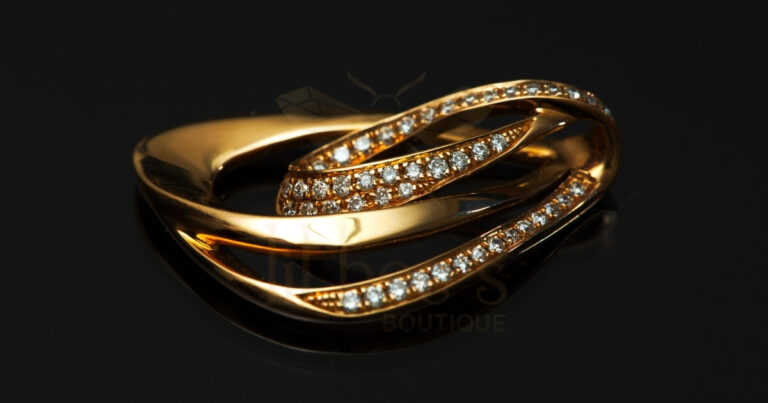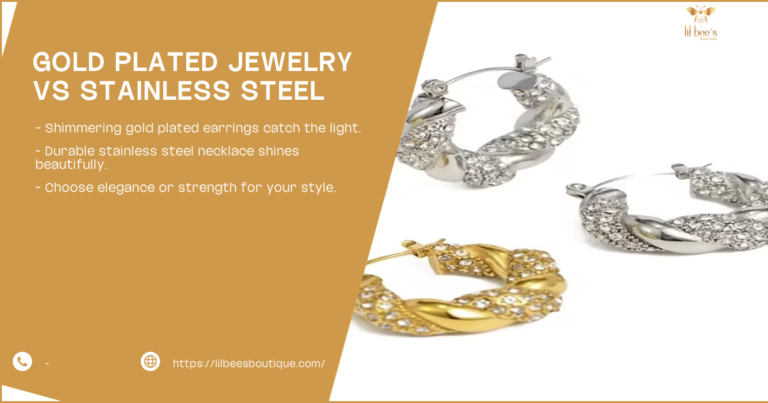Many people experience the frustration of their beloved gold plated jewelry accessories turning black over time. Gold plating is a process where a thin layer of gold is applied to a base metal, such as brass, copper, or silver. This technique allows manufacturers to create jewelry with the appearance of solid gold at a fraction of the cost. However, the thinness of the gold layer makes it susceptible to wear and tarnishing over time.
Common Causes of Tarnishing
Several factors can contribute to gold plated jewelry turning black:
- Exposure to air and moisture
- Contact with chemicals in cosmetics, perfumes, and cleaning products
- Reaction with the wearer’s skin oils and sweat
- Friction from daily wear and tear
To better understand the tarnishing process, let’s look at the following table:
| Cause | Effect on Gold Plated Jewelry |
| Air and moisture | Oxidation of base metal |
| Chemicals | Corrosion of gold layer |
| Skin oils and sweat | Accelerated wear of plating |
| Friction | Physical removal of gold layer |
Factors Contributing to Gold Plated Jewelry Discoloration
Impurities in the Base Metal
The quality of the base metal used in gold plated jewelry plays a significant role in its longevity. Lower-quality base metals may contain impurities that can react with the environment and cause discoloration more quickly.
Quality of Gold Plating
The thickness and purity of the gold plating affect how long it will last before showing signs of wear. Thicker plating and higher karat gold are more resistant to tarnishing and discoloration.
Environmental Factors
Various environmental elements can impact the appearance of gold plated jewelry:
- Humidity levels
- Exposure to sunlight
- Contact with chlorine in swimming pools
- Presence of pollutants in the air
To minimize the impact of these factors, consider the following tips:
- Store jewelry in a cool, dry place
- Remove jewelry before swimming or bathing
- Avoid wearing gold plated pieces in hot, humid conditions
- Keep jewelry away from direct sunlight when not in use
Preventing Gold Plated Jewelry from Turning Black 
Proper Storage Techniques
Proper storage is crucial for maintaining the appearance of your gold plated jewelry. Here are some effective storage methods:
- Use individual cloth pouches or lined jewelry boxes
- Place silica gel packets in storage containers to absorb moisture
- Separate pieces to prevent scratching and tangling
- Store in a cool, dry location away from direct sunlight
Avoiding Exposure to Chemicals
Chemicals found in everyday products can damage gold plating. To protect your jewelry:
- Remove jewelry before applying lotions, perfumes, or cosmetics
- Avoid wearing gold plated pieces while cleaning or using harsh chemicals
- Wait for skincare products to fully absorb before putting on jewelry
Removing Jewelry Before Activities
Certain activities can accelerate the wear of gold plated jewelry. Remove your pieces before:
- Swimming in chlorinated pools or saltwater
- Exercising or engaging in sports
- Taking a shower or bath
- Doing household chores
By following these preventive measures, you can significantly extend the life of your gold plated jewelry.
Cleaning and Restoring Tarnished Gold Plated Jewelry
Safe Cleaning Methods
When your gold plated jewelry starts to show signs of tarnishing, gentle cleaning can help restore its luster. Here are some safe cleaning methods:
- Mild soap and water solution:
- Mix a few drops of mild dish soap with warm water
- Gently clean the jewelry with a soft cloth
- Rinse thoroughly and pat dry with a clean, lint-free cloth
- Baking soda paste:
- Create a paste with baking soda and water
- Apply to the jewelry with a soft cloth, rubbing gently
- Rinse well and dry completely
- Lemon juice and baking soda:
- Mix equal parts lemon juice and baking soda
- Apply the mixture to the jewelry with a soft brush
- Rinse and dry thoroughly
Professional Restoration Options
For heavily tarnished or worn gold plated jewelry, professional restoration may be necessary. Options include:
- Re-plating: A jeweler can apply a new layer of gold plating
- Polishing: Professional polishing can remove light tarnish and restore shine
- Base metal repair: In some cases, the underlying metal may need to be repaired before re-plating
At Lil Bee’s Boutique, we offer expert jewelry cleaning and restoration services to help keep your gold plated pieces looking their best.
Maintaining the Luster of Gold Plated Accessories 
Regular Polishing Techniques
Regular polishing can help maintain the shine of your gold plated jewelry:
- Use a jewelry polishing cloth specifically designed for gold
- Gently buff the surface in circular motions
- Avoid applying too much pressure to prevent wearing down the plating
Protective Measures for Longevity
To extend the life of your gold plated jewelry:
- Apply a thin layer of clear nail polish to areas prone to wear
- Consider having your jewelry professionally sealed with a protective coating
- Rotate your jewelry to prevent excessive wear on any one piece
By incorporating these maintenance practices, you can enjoy your gold plated accessories for longer periods without discoloration. Rose gold jewelry trends Soft pink-tinted metal is becoming more popular for rings necklaces and bracelets Many people like how it looks with different skin tones Gold alloy compositions
Gold color variations Gold can look different depending on how much light shines on it ranging from pale yellow to deep orange and sometimes even has a reddish tint Gold jewelry comparison Different gold jewelry pieces can be compared by looking at their color weight and design to see which one you like best
Precious metals comparison Gold silver and platinum are often compared to see which is most valuable and useful for different purposes like jewelry or investments Elegant gold-plated presents are shiny and fancy gifts that look expensive They make people feel special when they receive
Hypoallergenic gold earrings Gold jewelry electroplating is a process that adds a thin layer of gold to jewelry made from other metals This technique makes jewelry look like solid gold without the high cost of pure gold items Gold jewelry longevity Gold jewelry can last for many years without tarnishing or losing its shine making it a great choice for long-lasting accessories that can be passed down through generations
Jewelry material differences Different materials used in jewelry like gold silver and gemstones have unique qualities that affect how the jewelry looks feels and lasts Lustrous budget accessories shine bright without breaking the bank They offer affordable glamour for those who want to sparkle on a budget
Durable gold plating is a special coating that makes things look like gold and last longer It protects jewelry and other items from wear and tear while giving them a shiny golden appearance
Choosing High-Quality Gold Plated Jewelry
Understanding Plating Thickness
The thickness of the gold plating is measured in microns. Higher-quality gold plated jewelry typically has a thicker layer of gold:
| Plating Thickness | Quality Level | Expected Longevity |
| 0.5 – 1 micron | Low | 6 months to 1 year |
| 1 – 2.5 microns | Medium | 1 to 2 years |
| 2.5+ microns | High | 2+ years |
Selecting Reputable Manufacturers
When purchasing gold plated jewelry , consider:
- Researching the manufacturer’s reputation
- Reading customer reviews and testimonials
- Checking for quality certifications or guarantees
- Opting for pieces from established jewelry brands
At Lil Bee’s Boutique, we carefully curate our selection of gold plated jewelry to ensure our customers receive high-quality pieces that maintain their beauty over time.







